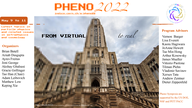Speaker
Description
We propose a technique to measure the top quark mass using $B$-hadron decay lengths extracted from $ t \bar{t}$ events. When the top quark is produced unpolarized with an arbitrary boost distribution, the peak of the $b$ quark's energy distribution is identical to its single-valued energy in the rest frame of the top quark. The peak energy is a function of the top quark's mass and the mass of the other decay product, the $W$ boson, measured independently. This measurement of the top mass using the energy peak idea is less sensitive to the production mechanism of the top quark. The original proposal, implemented by the CMS collaboration, used $b$-jet energy as an approximation to the $b$ quark energy. However, $b$-jet energies suffer from the jet energy scale (JES) uncertainty. Instead, we propose using the $B$-hadron decay length as a proxy for the $b$ quark energy. We then merge the two ideas: use $B$-hadron decay lengths to obtain the $b$ quark energy distribution, whose peak determines the mass of the top quark. This measurement would be free of JES uncertainty and insensitive to top quark production. We implement this proposal using Monte Carlo generated data via MadGraph5 and parton showering via Pythia8 and compare our results to a SM-dependent measurement using transverse $B$-hadron decay lengths, a technique used by CMS.

